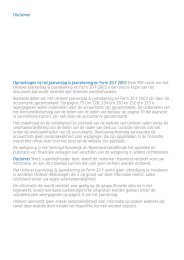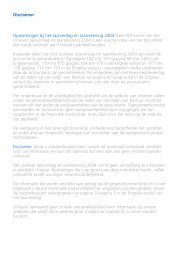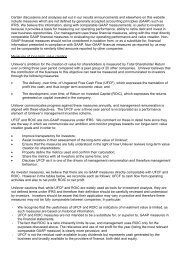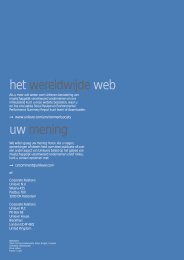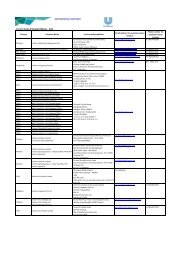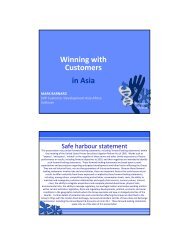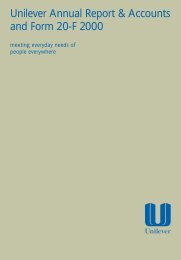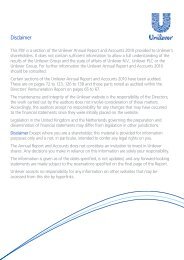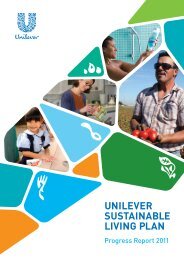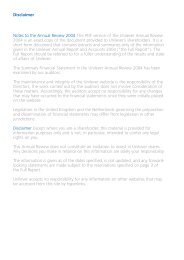Meeting everyday needs of people everywhere - Unilever
Meeting everyday needs of people everywhere - Unilever
Meeting everyday needs of people everywhere - Unilever
Create successful ePaper yourself
Turn your PDF publications into a flip-book with our unique Google optimized e-Paper software.
Financial review<br />
Total borrowings at the end <strong>of</strong> 1999 totalled<br />
Fl. 10 553 million (1998: Fl. 10 146 million). More than<br />
one third <strong>of</strong> <strong>Unilever</strong>’s total borrowings are in euros,<br />
approximately one third in US dollars and the remainder<br />
spread over a large number <strong>of</strong> other currencies.<br />
Long-term debt fell by Fl. 939 million to Fl. 4 084 million.<br />
Debt totalling Fl. 1 464 million was reclassified to shortterm<br />
at the year end and there were no significant new<br />
long-term borrowings. The maturity pr<strong>of</strong>ile is spread over<br />
an eight year period to 2007. Some 85% <strong>of</strong> the long-term<br />
debt was repayable within five years at the end <strong>of</strong> 1999<br />
(1998: 60%).<br />
<strong>Unilever</strong> has commercial paper programmes in place in the<br />
United States and Europe for short-term finance purposes.<br />
In addition, operating subsidiaries fund part <strong>of</strong> their dayto-day<br />
<strong>needs</strong> through local bank borrowings. At the end<br />
<strong>of</strong> 1999 short-term borrowings were Fl. 6 469 million<br />
(1998: Fl. 5 123 million).<br />
Cash and current investments at the end <strong>of</strong> 1999 totalled<br />
Fl. 12 061 million (1998: Fl. 22 881 million); these funds<br />
a re held in euros (52%), US dollars (17%), sterling (12%)<br />
and other currencies (19%). The funds are mainly invested<br />
in short-term bank deposits and high-grade marketable<br />
securities.<br />
Assets held in foreign currencies are, to a considerable<br />
extent, financed by borrowings in the same currencies.<br />
Consequently, at the end <strong>of</strong> 1999 some 51% (1998: 57%<br />
before accounting for the special dividend) <strong>of</strong> <strong>Unilever</strong>’s<br />
total capital and reserves were denominated in the<br />
currencies <strong>of</strong> the two parent companies, euro and sterling.<br />
From an earnings perspective, some 43% <strong>of</strong> <strong>Unilever</strong>’s<br />
1999 net income was denominated in the euro, 14% in<br />
sterling and 15% in the US dollar.<br />
Treasury and hedging policies<br />
<strong>Unilever</strong>’s Treasury aims to be excellent in meeting the<br />
business requirements for finance and financial services,<br />
with its prime objective being to minimise the cost <strong>of</strong> debt<br />
and maintain <strong>Unilever</strong>’s financial strength. The Group<br />
Treasury function is governed by financial policies and<br />
plans agreed by the directors, and operates as a cost<br />
centre. In addition to policies, guidelines and exposure<br />
limits, a system <strong>of</strong> authorities and extensive independent<br />
reporting covers all major areas <strong>of</strong> activity.<br />
Performance is monitored closely. Independent reviews are<br />
undertaken by the corporate internal audit function.<br />
<strong>Unilever</strong> has an interest rate management policy aimed<br />
at optimising net interest and reducing volatility. This is<br />
achieved by modifying the underlying interest rate<br />
exposure <strong>of</strong> debt and cash positions through the use <strong>of</strong><br />
straightforward derivative instruments. The proportion <strong>of</strong><br />
fixed rate cash and fixed rate debt was reduced in 1999 in<br />
line with changes in the recommended fixing levels within<br />
this policy.<br />
Under the Group’s foreign exchange policy, trading and<br />
financial exposures are generally hedged, mainly through<br />
the use <strong>of</strong> forward foreign exchange contracts. Some<br />
flexibility is permitted within overall exposure limits.<br />
Managing market risks<br />
The Group is exposed to a variety <strong>of</strong> market risks,<br />
including the effects <strong>of</strong> changes in foreign currency<br />
exchange rates, interest rates and credit spreads. In the<br />
normal course <strong>of</strong> business, the Group also faces risks that<br />
are either non-financial or non-quantifiable, eg country<br />
and counterparty risk.<br />
Counterparty exposures are minimised by restricting<br />
dealing counterparties to a limited number <strong>of</strong> financial<br />
institutions that have secure credit ratings, by working<br />
within agreed counterparty limits and by setting limits on<br />
the maturity <strong>of</strong> investments. Counterparty credit ratings<br />
are closely monitored and concentration <strong>of</strong> credit risk with<br />
any single counterparty is avoided.<br />
The Group uses straightforward derivative financial<br />
instruments, eg interest rate swaps, forward rate<br />
agreements and forward exchange contracts, to manage<br />
the market risks associated with the underlying assets,<br />
liabilities and anticipated transactions. The Group uses<br />
these derivative financial instruments to reduce risk by<br />
creating <strong>of</strong>fsetting market exposures. The use <strong>of</strong> leveraged<br />
instruments is not permitted.<br />
The following discussion about our risk-management<br />
activities includes ‘forward-looking’ statements that<br />
involve risk and uncertainties. Our actual results could<br />
differ materially from those projected.



